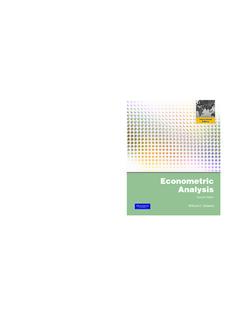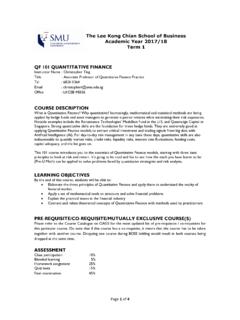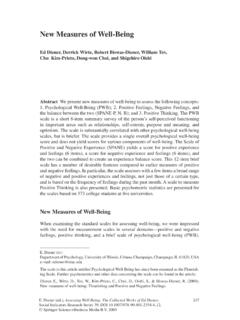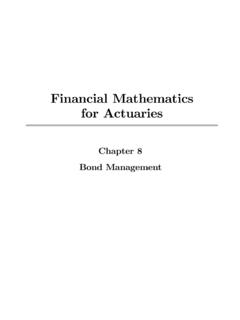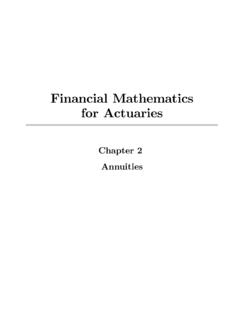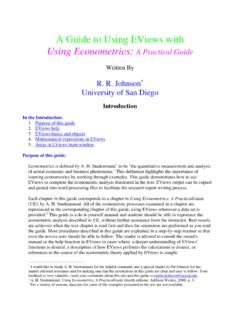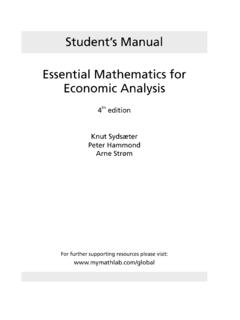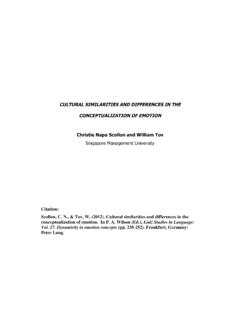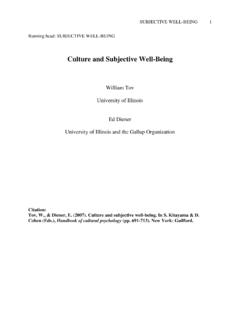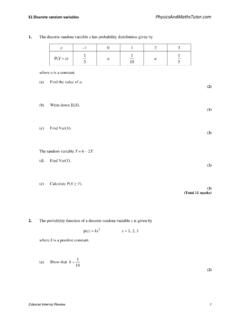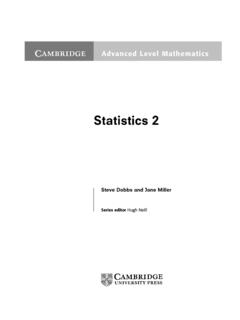Transcription of Chapter 1 Claim-Frequency Distribution
1 Nonlife Actuarial ModelsChapter 1 Claim-Frequency DistributionLearning Objectives discrete distributions for modeling claim frequency Binomial, geometric, negative binomial and Poisson distributions The (a, b,0) and (a, b,1) classes of distributions Compound Distribution Convolution Mixture Review of Statistics Distribution function(df) of random variableXFX(x)=Pr(X x).( ) Probability density function(pdf) of continuous random vari-ablefX(x)=dFX(x)dx.( ) Probability function(pf) of discrete random variablefX(x)=(Pr(X=x),ifx X,0,otherwise.( )where Xis the support ofX3 Moment generating function(mgf), defined asMX(t)=E(etX).( ) Moments ofXare obtainable from mgf byMrX(t)=drMX(t)dtr=drdtrE(etX)=E(XretX) ,( )so thatMrX(0) = E(Xr)= 0r.( )4 IfX1,X2, ,Xnareindependently and identically distrib-uted (iid)random variables with mgfM(t), andX=X1+ +Xn,then the mgf ofXisMX(t)=E(etX)=E nYi=1etXi!)
2 =nYi=1E(etXi)=[M(t)]n.( ) Probability generating function(pgf), defined asPX(t)=E(tX),PX(t)= Xx=0txfX(x),( )so that forXtaking nonnegative integer values. We havePrX(t)= Xx=rx(x 1) (x r+1)tx rfX(x)( )5so thatfX(r)=PrX(0)r! Raw moments can be obtained by differentiating mgf, pf can be obtained by differentiating pgf. The mgf and pgf are related through the following equationsMX(t)=PX(et),( )andPX(t)=MX(logt).( ) Some discrete Distributions(1) Binomial Distribution :X BN(n, )iffX(x)= nx! x(1 )n x,forx=0,1, ,n,( ) The mean and variance ofXareE(X)=n and Var(X)=n (1 ),( )so that the variance ofXis always smaller than its mean. How do you prove these results? The mgf ofXisMX(t)=( et+1 )n,( )7and its pgf isPX(t)=( t+1 )n.( ) A recursive relationship forfX(x)isfX(x)="(n x+1) x(1 )#fX(x 1)( )(2) Geometric Distribution :X GM( )iffX(x)= (1 )x,forx=0,1.
3 ( ) The mean and variance ofXareE(X)=1 and Var(X)=1 2,( )8 How do you prove these results? The mgf ofXisMX(t)= 1 (1 )et,( )and its pgf isXPX(t)= 1 (1 )t.( ) The pf satisfies the following recursive relationshipfX(x)=(1 )fX(x 1),( )forx=1,2, , with starting valuefX(0) = .9(3) Negative Binomial Distribution :X NB(r, )iffX(x)= x+r 1r 1! r(1 )x,forx=0,1, ,( ) The mean and variance areE(X)=r(1 ) and Var(X)=r(1 ) 2,( ) The mgf ofNB(r, )isMX(t)=" 1 (1 )et#r,( )and its pgf isPX(t)=" 1 (1 )t#r.( )10 May extend the parameterrto any positive number (not necessarilyinteger). The recursive formula of the pf isfX(x)="(x+r 1)(1 )x#fX(x 1),( )with starting valuefX(0) = r.( )(4) Poisson Distribution :X PN( ), if the pf ofXis given byfX(x)= xe x!,forx=0,1, ,( ) The mean and variance ofXareE(X)=Var(X)=.
4 ( )11 The mgf ofXisMX(t)=exph (et 1)i,( )and its pgf isPX(t)=exp[ (t 1)].( ) Two important theorems of Poisson Distribution Theorem :IfX1, ,Xnare independently distributed withXi PN( i), fori=1, ,n,thenX=X1+ +Xnis distributedas a Poisson with parameter = 1+ + Proof:To prove this result, we make use of the mgf. Note thatthe mgf ofXisMX(t)=E(etX)=E(etX1+ +tXn)=E nYi=1etXi!=nYi=1E(etXi)=nYi=1exph i(et 1)i=exp"(et 1)nXi=1 i#=exph(et 1) i,( )which is the mgf ofPN( ).13 Theorem :Suppose an eventAcan be partitioned intommutually exclusive and exhaustive eventsAi,fori=1, , the number of occurrences ofA,andXibe the number ofoccurrences ofAi,sothatX=X1+ +Xm. Let the probabilityof occurrence ofAigivenAhas occurred bepi, , Pr(Ai|A)=pi,withPmi=1pi= PN( ), thenXi PN( i), where i= ,X1, ,Xnare independently distributed.
5 Proof:To prove this result, wefirst derive the marginal distribu-tion ,Xi BN(x, pi).Hence, the marginal pf ofXiis pf ofPN( pi).Then we show that the joint pf ofX1, ,Xmis the product of their marginal pf, so thatX1, ,Xmare :Some discrete distributionsDistribution, parameters,notation and supportpffX(x)mgfMX(t)MeanVarianceBinomi alBN(n, )x {0,1, ,n} nx x(1 )n x( et+1 )nn n (1 )PoissonPN( )x {0,1, } xe x!exp (et 1) GeometricGM( )x {0,1, } (1 )x 1 (1 )et1 1 2 Negative binomialNB(r, )x {0,1, } x+r 1r 1 r(1 )xh 1 (1 )etirr(1 ) r(1 ) The(a, b,0)Class of Distributions Definition :A nonnegative discrete random variableXis inthe (a, b,0) class if its pffX(x)satisfies the following recursionfX(x)= a+bx!fX(x 1),forx=1,2, ,( )whereaandbare constants, with givenfX(0).
6 As an example, we consider the binomial Distribution . Its pf can bewritten as followsfX(x)=" 1 + (n+1)(1 )x#fX(x 1).( )Thus, we leta= 1 andb= (n+1)(1 ).( )16 Binomial, geometric, negative binomial and Poisson belong to the(a, b,0) class of :The (a, b,0) class of distributionsDistributionabfX(0)Binomial :BN(n, ) 1 (n+1)1 (1 )nGeometric:GM( )1 0 Negative binomial:NB(r, )1 (r 1)(1 ) rPoisson:PN( )0 e 17 It may be desirable to obtain a goodfit of the Distribution at zeroclaim based on empirical experience and yet preserve the shape tocoincide with some simple parametric distributions. This can be achieved by specifying the zero probability while adopt-ing the recursion to mimic a selected (a, b,0) Distribution . LetfX(x) be the pf of a (a, b,0) Distribution called the base distri-bution.
7 We denotefMX(x)asthepfthatisamodification offX(x). The probability at point zero,fMX(0), is specified andfMX(x)isre-lated tofX(x)asfollowsfMX(x)=cfX(x),forx=1,2, ,( )wherecis an appropriate ForfMX( )tobeawelldefined pf, we must have1=fMX(0) + Xx=1fMX(x)=fMX(0) +c Xx=1fX(x)=fMX(0) +c[1 fX(0)].( )Thus, we conclude thatc=1 fMX(0)1 fX(0).( )Substitutingcinto equation ( ) we obtainfMX(x), forx=1,2, . Together with the givenfMX(0), we have a Distribution with thedesired zero- claim probability and the same recursion as the base(a, b,0) This is called thezero-modified distributionofthebase(a, b,0) Distribution . In particular, iffMX(0) = 0, the modified Distribution cannot takevalue zero and is called thezero-truncated Distribution . The zero-truncated Distribution is a particular case of the zero-modified Methods for Creating New Compound Distribution LetX1, ,XNbe iid nonnegative integer-valued random variables,each distributed likeX.
8 We denote the sum of these random vari-ables byS,sothatS=X1+ +XN.( ) IfNis itself a nonnegative integer-valued random variable distrib-uted independently ofX1, ,XN,thenSis said to have acom-pound Distribution . The Distribution ofNis called theprimary Distribution ,andthedistribution ofXis called thesecondary We shall use theprimary-secondaryconvention to name a compounddistribution. Thus, ifNis Poisson andXis geometric,Shas a Poisson-geometricdistribution. Acompound Poissondistribution is a compound distributionwhereNis Poisson, foranysecondary Distribution . Consider the simple case whereNhas a degenerate distributiontaking valuenwith probability then the sum ofnterms ofXi,wherenisfixed. Supposen=2,sothatS=X1+X2. As the pf ofX1andX2arefX( ),the pf ofSis given by22fS(s)=Pr(X1+X2=s)=sXx=0Pr(X1=xandX2= s x)=sXx=0fX(s)fX(s x),( )where the last line above is due to the independence ofX1andX2.
9 The pf ofS,fS( ), is theconvolutionoffX( ), denoted by (fX fX)( ), ,fX1+X2(s)=(fX fX)(s)=sXx=0fX(x)fX(s x).( ) Convolutions can be evaluated recursively. Whenn=3,the3-fold23convolution isfX1+X2+X3(s)=(fX1+X2 fX3)(s)=(fX1 fX2 fX3)(s)=(fX fX fX)(s).( ) Example :Let the pf ofXbefX(0) = ,fX(1) = 0,fX(2) = (3) = Find the 2-fold and 3-fold convolutionsofX. Solution:Wefirst compute the 2-fold convolution. Fors=0and1, the probabilities are(fX fX)(0) =fX(0)fX(0) = ( )( ) = ,and(fX fX)(1) =fX(0)fX(1) +fX(1)fX(0) = ( )(0) + (0)( ) = values are similarly computed as follows(fX fX)(2) = ( )( ) + ( )( ) = ,(fX fX)(3) = ( )( ) + ( )( ) = ,(fX fX)(4) = ( )( ) = ,(fX fX)(5) = ( )( ) + ( )( ) = ,and(fX fX)(6) = ( )( ) = the 3-fold convolution, we show some sample workings as followsf 3X(0) = [fX(0)]hf 2X(0)i=( )( ) = ,f 3X(1) = [fX(0)]hf 2X(1)i+[fX(1)]hf 2X(0)i=0,25andf 3X(2) = [fX(0)]hf 2X(2)i+[fX(1)]hf 2X(1)i+[fX(2)]hf 2X(0)i= The results are summarized in Table We now return to the compound Distribution in which the primarydistributionNhasapffN( ).
10 Using the total law of probability, weobtain the pf of the compound distributionSasfS(s)= Xn=0Pr(X1+ +XN=s|N=n)fN(n)= Xn=0Pr(X1+ +Xn=s)fN(n),in which the term Pr(X1+ +Xn=s) can be calculated as then-fold convolution offX( ).26 The evaluation of convolution is usually quite complex whennislarge. Theorem :LetSbe a compound Distribution . If the primarydistributionNhas mgfMN(t) and the secondary distributionXhasmgfMX(t),then the mgf ofSisMS(t)=MN[logMX(t)].( )IfNhas pgfPN(t)andXis nonnegative integer valued with pgfPX(t), then the pgf ofSisPS(t)=PN[PX(t)].( ) Proof:The proof makes use of results in conditional note that27MS(t)=E etS =E etX1+ +tXN =EhE etX1+ +tXN|N i=E hE etX iN =En[MX(t)]No=E helogMX(t)iN =MN[logMX(t)].( ) Similarly we getPS(t)=PN[PX(t)]. To compute the pf (0) =PS(0) =PN[PX(0)],( )28 Also, we havefS(1) =P0S(0).
